Household silver
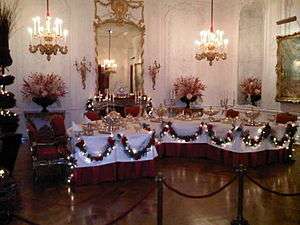
Household silver or silverware (the silver, the plate, or silver service) includes tableware, cutlery, and other household items made of sterling silver, Britannia silver, or Sheffield plate silver. Silver is sometimes bought in sets or combined to form sets, such as a set of silver candlesticks or a silver tea set.
Historically, silverware was divided into table silver, for eating, and dressing silver for bedrooms and dressing rooms. The grandest form of the latter was the toilet service, typically of 10-30 pieces, often silver-gilt, which was especially a feature of the period from 1650 to about 1780.
Silver requires a good deal of care, as it tarnishes and must be hand polished, since careless or machine polishing ruins the patina and can completely erode the silver layer in Sheffield plate.
A silverman or silver butler has expertise and professional knowledge of the management, secure storage, use, and cleaning of all silverware, associated tableware, and other paraphernalia for use at military and other special functions. This expertise covers the maintenance, cleaning, proper use, and presentation of these assets to create aesthetically correct layouts for effective ambience at such splendid occasions. The role of silverman tends now to be restricted to some private houses and large organizations, in particular the military.
One advantage of silverware is that growth of bacteria is inhibited by the oligodynamic effect.
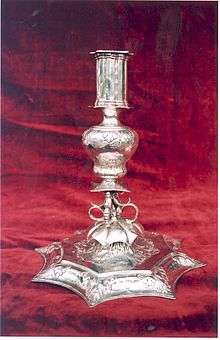 Sterling silver candlestick, One of a pair of candlesticks made for the 5th Earl of Bath's widow. Marks for silversmith Robert Cooper, London, and 1679. They bear the arms of the widow of the 5th Earl of Bath.
Sterling silver candlestick, One of a pair of candlesticks made for the 5th Earl of Bath's widow. Marks for silversmith Robert Cooper, London, and 1679. They bear the arms of the widow of the 5th Earl of Bath.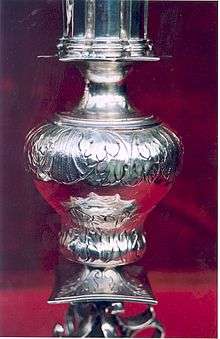
 Mark of Robert Cooper
Mark of Robert Cooper De Lamerie
De Lamerie Pair of salts, salver and cream jug bearing arms of family of Beachcroft. (Arms granted 12 Nov. 1717: Bendy of siz argent and gules three stags heads cabossed or. Crest: A beech tree proper behind six park pales argent.)
Pair of salts, salver and cream jug bearing arms of family of Beachcroft. (Arms granted 12 Nov. 1717: Bendy of siz argent and gules three stags heads cabossed or. Crest: A beech tree proper behind six park pales argent.)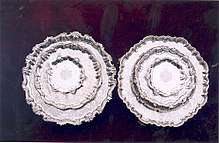 Seven salvers (c. 1735–1750). (Arms of Bisse (granted Ireland 25 May 1637): Sable three escalops in pale argent a canton ermine and a crescent for difference or. Crest: On a mount vert two snakes or, interlaced respecting each other.)
Seven salvers (c. 1735–1750). (Arms of Bisse (granted Ireland 25 May 1637): Sable three escalops in pale argent a canton ermine and a crescent for difference or. Crest: On a mount vert two snakes or, interlaced respecting each other.) A c. 1770 hot-water jug, Dublin
A c. 1770 hot-water jug, Dublin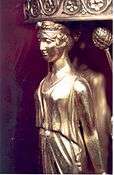 Paul Storr
Paul Storr GS & WF canteen laid out
GS & WF canteen laid out Coburg pattern canteen
Coburg pattern canteen Detail of a teapot
Detail of a teapot Detail of GS & WF forks. George Smith III and William Fearn
Detail of GS & WF forks. George Smith III and William Fearn
See also
- Cutlery
- Francis 1st silverware pattern
- Holloware
- The Armada Service
External links
